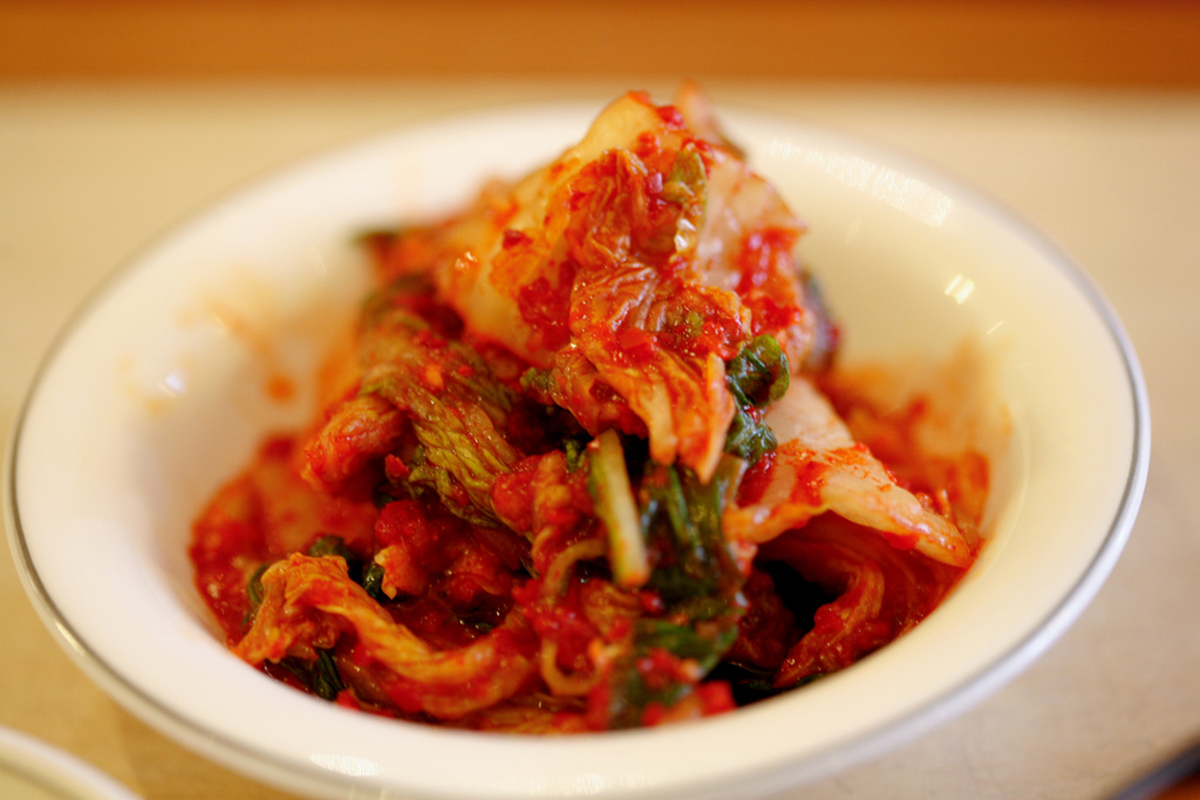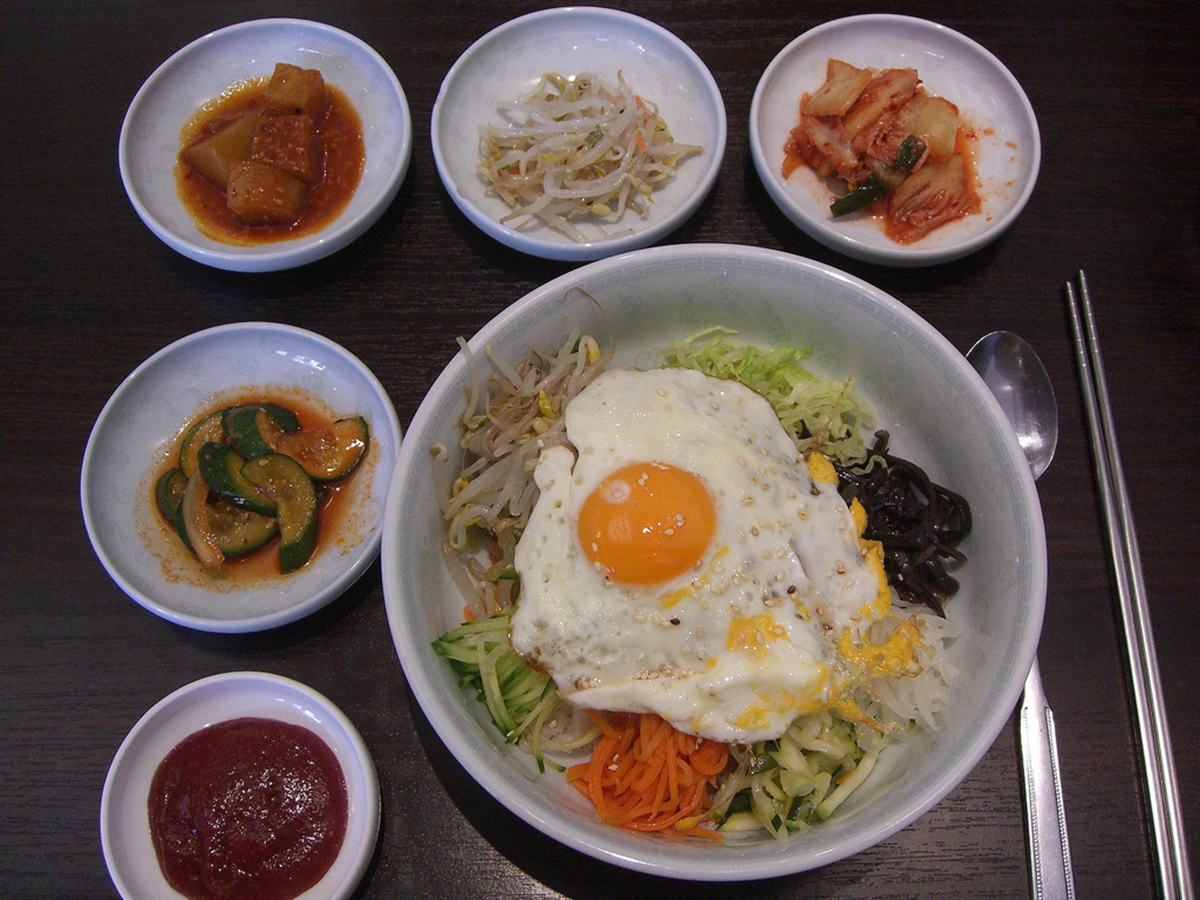If you were to ask just about anyone who is from Korea or who has spent substantial time in Korea, kimchi is the quintessential Korean food. Kimchi is a tangy preparation of fermented Napa cabbage or other vegetables, but it is not really accurate to refer to it just as a pickle. Kimchi is better described as Korean soul food. It appears on just about every table at just about every meal, breakfast, lunch, and dinner.

If your exposure to Korean food has been in restaurants, chances are that you have encountered this pungent vegetable prepartion as one of the ban chan, or side dishes, served with grilled meats or raymun (ramen) noodles. However, kimchi can also become the basis for soups, stews, pancakes, and rice dishes, adding sweetness and umami flavors that are difficult to duplicate with any other food.
What Is Kimchi?
Kimchi (김치), which is also spelled kimchee and gimchee, is a fermented preparation of various vegetables. The most common vegetable used for making kimchi is the tall, pale, Napa cabbage, but frugal cooks can also use turnips, cucumbers, and white (daikon) radishes, along with fresh green tops of scallions.
There are many different kinds of kimchi in Korea, not all of them spicy:
- White kimchi (baek kimchi) is Napa cabbage pickled without red pepper. It is white, not red, and is not spicy.
- White radish kimchi (dongchimi) is made from fermented daikon root, also without red pepper. It is sour but not spicy.
- Cucumber kimchi (oisibagi) is made from cucumbers and red peppers. It is both red and spicy.
- Cabbage kimchi (baechu kimchi) is made from Napa cabbage with red peppers. It is also both red and spicy. It may be complemented by pears, chestnuts, shredded chili peppers, garlic, ginger, and/or mannu, a kind of lichen.
- Unfermented cabbage kimchi (baechu geotjori) combines Napa cabbage that has not been allowed to ferment with red pepper and other seasonings.
- Green onion kimchi (pa kimchi) is made with scallion tops (the greens) and spices.
The primary spice used in making this popular vegetable dish is red pepper. South Koreans tend to use more red pepper than North Koreans. South Koreans also usually add myeolchijeot, fermented anchovies, or saeujeot, fermented brine shrimp, for additional, meaty flavor, in much the same way as people in other parts of Asia use fish sauce. (If you are allergic to shellfish, be careful with kimchi.)
Fresh vegetables are washed thoroughly with cold water and then salted and chopped. They are packed into containers with layers of red pepper and other seasonings, and then allowed to ferment for several days until the vegetables float in a briny broth. It's not especially unusual for beginners to experience literally exploding kimchi that they have to scrape off the kitchen ceiling when they don't get the fermentation temperature and the packing right. Modern Korean kitches often have kimchi refrigerators to keep the mix at just the right temperature for optimum fermentation and maximum flavor.
How important is kimchi to the Korean diet? Before Korea sent its own astronaut to the Soyuz Space Station, scientists perfected a process to remove bacteria from the product and lessen odor without hurting taste. In 2012, the South Korean government banned the exportation of kimchi, to ensure an adequate supply at home.
See Also: Korean Poop Liquor: A Cure All, Or A Reason To Vomit?
What Are The Health Benefits Of Eating Kimchi?
The fermentation process concentrates calcium, beta-carotene, riboflavin (vitamin B2), niacin, and vitamin C in kimchi. The Lactobacillus bacteria that ferment the vegetables are probiotic, helping with digestion, and sometimes protecting against disease. There is some evidence that eating kimchi prevents colon cancer (although extremely high consumption can actually increase the risk of stomach cancer), and one Korean study found that eating kimchi protects against the H1N1 influenza virus.
How Can You Use More Kimchi In Cooking?
Most non-Koreans have limited success with making their own kimchi (although it's not that hard to learn) and prefer to buy their kimchi at the supermarket or the Korean specialty store. Store-bought kimchi can be just as delicious and nutritious as what most of us would make at home. It can be eaten as a side dish or a salad, but it can also be used creatively to make main courses.

- Make kimchi jigae, also known as kimchi soup. This popular cold-weather dish is a slow simmer of kimchi with pork belly. Slow-cooking kimchi brings out sugars and umami flavors of the fish or shrimp used when it was pickled. This is not a low-calorie dish. The pork belly is cubed and marinated with ginger, garlic, soy sauce, and fish sauce for 10 to 15 minutes, and then sauteed in butter or olive oil for 5 minutes. At this point, chopped onions are added to the pork belly cubes and cooked until they are translucent. The pork and onions are topped with broth and kimchi juice, along with gochujang (a Korean “hot sauce,” available in speciality shops), and gochujaru (chili flakes, also available in specialty shops), and simmered another 10 or 15 minutes. Just before serving, cubed tofu and chopped scallions are added to the soup. This is an interesting soup even if the pork is left out.
- Make a kimchi noodle cake, sometimes referred to as a kimchi pancake. Rehydrate rice noodles in boiling water, and then drain and rinse with cold water. Stir-fry the noodles with sesame oil, sesame seeds, gochujang, and scallions, until the noodles begin to brown and look wavy. Then add beaten eggs and kimchi to make a fritatta, cooking until the eggs are set.
- Use kimchi in salads. This is the best way to use “instant,” home-made kimchi. Chop Napa cabbage, fresh greens into edible chunks, toss with bean sprouts, and set aside. Mix gochujan (the sauce), gochujaru (the red pepper flakes), soy sauce, anchovy or fish sauce, and then add the vegetables, toss, and allow to temper for 5 to 15 minutes. Serve as a salad or even as a vegetarian, low-calorie main course.
See Also: Siberian Ginseng: The Workhorse Herb For Keeping You Healthy
There is one more thing everyone needs to know for success with kimchi. Don't get in a hurry to open the jar. Keep kimchi in the refrigerator in a tightly closed container, and open the jar slowly, allowing gases to escape, in the sink. This will help you avoid making your kimchi meals memorable in more ways than one.
- David Tanis. ‘Instant’ Kimchi With Greens and Bean Sprouts. New York Times. http://cooking.nytimes.com/recipes/1017143-instant-kimchi-with-greens-and-bean-sprouts,. Accessed 17 February 2015.
- Rister, R. Healing without Medication. Basic Health Publications, 2003.
- Photo courtesy of Charles Haynes via Flickr: www.flickr.com/photos/haynes/3535737658
- Photo courtesy of avlxyz via Flickr: www.flickr.com/photos/avlxyz/2753530146


Your thoughts on this